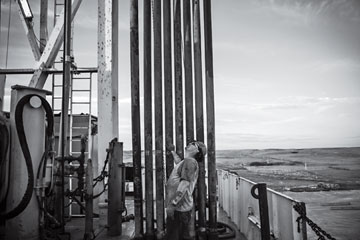
Fracking has unlocked new oil supplies in states like North Dakota, reducing crude imports.
(4 of 6)
Of course, those projections assume that the new energy boom is sustainable. Some analysts have their doubts. Unconventional oil wells deplete quickly, which means that companies have to drill over and over just to keep production steady. Right now shale oil extraction is profitable only while the price of oil remains high; the boom could end if prices fall. And then there are the environmental limitations. Fracking uses less water than farming or industry, but it still requires millions of gallons per well, which is already becoming an obstacle in arid states like Colorado. And while states like Texas and North Dakota have embraced fracking wholeheartedly, local fears about water contamination have stopped drilling in gas-rich New York and are likely to slow it elsewhere. The next big shale resource is in California, where influential environmentalists want nothing short of a ban on fracking. "There is no safe way to frack," says Becky Bond, president of CREDO, a green super PAC. "It endangers communities with water contamination, toxic air emissions and climate change."
Energy companies are working to mitigate local pollution from unconventional oil and gas exploitation, though not as fast as environmentalists and many local residents demand. But the shale revolution won't stop while the U.S. still relies on oil and natural gas for much of its energy. Green activists have persuaded President Obama to delay the proposed Keystone XL oil-sands pipeline, but they haven't been able to persuade him to curtail fracking. In his most recent State of the Union speech, Obama boasted about rising domestic oil production and said, "After years of talking about it, we are finally poised to control our own energy future."
Renewed Clout
But the biggest source of new electricity in the U.S. last year wasn't a fossil fuel. It was the humble wind. More than 13 gigawatts of new wind potential were added to the grid in 2012, accounting for 43% of all new generation capacity. Total wind-power capacity exceeded 60 gigawatts by the end of 2012--enough to power 15 million homes when the breeze is blowing. Nine states, including Iowa, South Dakota and Kansas, rely on wind for more than 20% of their total electricity consumption. "We went mainstream," says Tom Kiernan, president of the American Wind Energy Association.
Solar is not far behind. The price of a crystalline solar panel has dropped from $76.77 per watt in 1977 to less than $1 per watt today. Over the same period, solar generation has gone from essentially zero to 4.3 million megawatt hours. This fall will see the full launch of the Ivanpah Solar Electric Generating System in the Mojave Desert on the California-Nevada border. At 377 megawatts, Ivanpah--which has curved mirrors to reflect the desert sunshine and generate steam--will be the largest solar power plant in the world, using the sun's heat to create electricity. Meanwhile, production of corn-based ethanol--though down a bit thanks to a major drought in the Midwestern Corn Belt--reached 13.3 billion gal. in 2012, displacing nearly half a billion barrels of oil. And the first commercial cellulosic biofuel plant--which relies on sources like wood chips and switchgrass that can't be used for food--opened in Mississippi last fall. The industry as a whole expects to produce about 200 million gal. this year.
